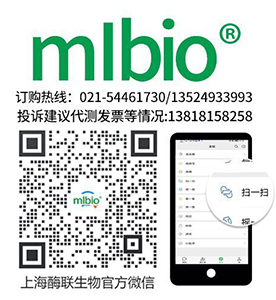產品貨號 : mlR10767
英文名稱 : MAGEG1
中文名稱 : 黑色素瘤相關抗原G1/肝癌相關蛋白4抗體
別 名 : HCA4; NDNL2; MAGG1_HUMAN; hepatocellular carcinoma-associated protein 4; hepatocellular carcinoma-associated protein HCA4; MAGE-G1 antigen; MAGEG1; MAGEL3; melanoma antigen, family G, 1; melanoma-associated antigen G1; necdin-like 2; necdin-like gene 2; necdin-like protein 2; NSE3; NSMCE3.
抗體來源 : Rabbit
克隆類型 : Polyclonal
交叉反應 : Human, Mouse, Rat, Pig, Cow, Sheep,
產品應用 : WB=1:500-2000 ELISA=1:500-1000 IHC-P=1:400-800 IHC-F=1:400-800 ICC=1:100-500 IF=1:100-500 (石蠟切片需做抗原修復)
not yet tested in other applications.
optimal dilutions/concentrations should be determined by the end user.
分 子 量 : 34kDa
細胞定位 : 細胞核 細胞漿
性 狀 : Lyophilized or Liquid
濃 度 : 1mg/ml
免 疫 原 : KLH conjugated synthetic peptide derived from human MAGEG1:181-280/304
亞 型 : IgG
純化方法 : affinity purified by Protein A
儲 存 液 : 0.01M TBS(pH7.4) with 1% BSA, 0.03% Proclin300 and 50% Glycerol.
保存條件 : Store at -20 °C for one year. Avoid repeated freeze/thaw cycles. The lyophilized antibody is stable at room temperature for at least one month and for greater than a year when kept at -20°C. When reconstituted in sterile pH 7.4 0.01M PBS or diluent of antibody the antibody is stable for at least two weeks at 2-4 °C.
PubMed : PubMed
產品介紹 : The protein encoded by this gene is part of the SMC5-6 chromatin reorganizing complex and is a member of the MAGE superfamily. This is an intronless gene. [provided by RefSeq, May 2011].
Function:
Component of the SMC5-SMC6 complex, a complex involved in repair of DNA double-strand breaks by homologous recombination. The complex may promote sister chromatid homologous recombination by recruiting the SMC1-SMC3 cohesin complex to double-strand breaks. The complex is required for telomere maintenance via recombination in ALT (alternative lengthening of telomeres) cell lines and mediates sumoylation of shelterin complex (telosome) components which is proposed to lead to shelterin complex disassembly in ALT-associated PML bodies (APBs). In vitro enhances ubiquitin ligase activity of NSMCE1. Proposed to act through recruitment and/or stabilization of the Ubl-conjugating enzyme (E2) at the E3:substrate complex. May be a growth suppressor that facilitates the entry of the cell into cell cycle arrest.
Subunit:
Component of the SMC5-SMC6 complex which consists at least of SMC5, SMC6, NSMCE2, NSMCE1, NSMCE4A or EID3 and NDNL2. NSMCE1, NSMCE4A or EID3 and NDNL2 probably form a subcomplex that bridges the head domains of the SMC5:SMC6 heterodimer. Interacts with PJA1. Binds the C-terminus of E2F1 and NGFR.
Subcellular Location:
Cytoplasm. Nucleus. Chromosome, telomere (Probable).
Tissue Specificity:
Ubiquitous.
Post-translational modifications:
Phosphorylated upon DNA damage, probably by ATM or ATR.
Similarity:
Contains 1 MAGE domain.
SWISS:
Q96MG7
Gene ID:
56160
Important Note:
This product as supplied is intended for research use only, not for use in human, therapeutic or diagnostic applications.











